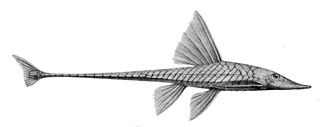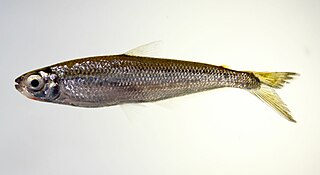The Percopsiformes are a small order of freshwater teleost fishes measuring less than 20 cm in length, comprising the trout-perch and its allies. It contains just ten extant species, grouped into seven genera and three families. Five of these genera are monotypic.

The Poeciliidae are a family of freshwater fishes of the order Cyprinodontiformes, the tooth-carps, and include well-known live-bearing aquarium fish, such as the guppy, molly, platy, and swordtail. The original distribution of the family was the Southeastern United States to north of Río de la Plata, Argentina, and Africa, including Madagascar. Due to release of aquarium specimens and the widespread use of species of the genera Poecilia and Gambusia for mosquito control, though, poeciliids can today be found in all tropical and subtropical areas of the world. In addition, Poecilia and Gambusia specimens have been identified in hot springs pools as far north as Banff, Alberta.

Ancistrus is a genus of nocturnal freshwater fish in the family Loricariidae of order Siluriformes, native to freshwater habitats in South America and Panama. Fish of this genus are common in the aquarium trade where they are known as bushynose or bristlenose catfish. In the aquarium hobby they are often referred to as bushynose or bristlenose plecos instead, but this may lead to confusion as "pleco" usually is used for Hypostomus plecostomus and its allies and is often used as a catchall term for any loricariids remotely resembling that species.

Astyanax is a genus of freshwater fish in the family Characidae of the order Characiformes. Some of these fish, like many of their relatives, are kept as aquarium pets and known collectively as tetras. With around 150 described species and new ones being described yearly, this genus is among the largest of the entire order; Hyphessobrycon also has more than 145 species and which one is larger at any one time depends on whether more species have been recently described in one or the other. The blind and colorless cave tetra of Mexico is a famous member of the genus, but its taxonomic position is disputed: Some recognize it as part of the Mexican tetra and this is supported by phylogenetic evidence, but others recognize the cave form as a separate species, A. jordani.

Leporinus is a genus of fish in the family Anostomidae native to South America. The fossil species Leporinus scalabrinii, known from the late Miocene of Entre Ríos in Argentina, has only recently been added to this genus after being misidentified as a species of primate under the name Arrhinolemur scalabrinii for over 100 years.

Astroblepus is a genus of fish in the family Astroblepidae found in South America and Panama. This genus is the only member of its family. These catfishes are primarily found in torrential streams in the Andean area. Astroblepus pholeter and A. riberae are troglobites adapted to living in subterranean water systems. These species are typically small, less than 10 cm (4 in). The largest species reaches 30 cm (1 ft). These fish have suckermouths like those of loricariids. They have two pairs of barbels, maxillary and nasal. The dorsal fin spine lacks a locking mechanism. These fish also have odontodes, tiny teeth on their skin. All species exhibit a conical, pointy type on their fin rays like that found in other loricarioids; other species also exhibit a blunt type that is only found on their skin.

Farlowella is a genus of fish in the family Loricariidae native to South America. This genus is broadly distributed in Amazon, Orinoco, Paraná and coastal rivers of the Guyana Shield. It is absent from the Pacific slope of the Andes and from the coastal rivers of the Brazilian Shield. Many of these species are kept in aquariums. This genus has a unique body shape that resembles a thin stick of wood. The body is slender and elongate, often with a pronounced rostrum and a brownish color with two lateral dark stripes beginning at the tip of the rostrum, passing over the eyes and ending at the tail, which are periodically interrupted on the caudal peduncle.

The giant talking catfish or giant raphael catfish is a species of thorny catfish that is native to the Amazon Basin in Bolivia, Brazil, Colombia, Ecuador and Peru. This species grows to a length of 60 centimetres (24 in) SL and a maximum weight of 4.6 kilograms (10 lb). These fish are harvested in local commercial fisheries.
Hisonotus is a genus of armored catfishes native to South America. Species of Hisonotus and Curculionichthys are the only representatives of the subfamily Otothyrinae having serrae on the posterior edge of the pectoral fin spine. These species are small fishes, generally found in small fast flowing streams, where they grasp to the branches and leaves of aquatic or subaquatic plants. The species of this genus mostly occur in Atlantic coastal streams of southern Brazil and the Paraguay-Paraná system of southern South America. They are also distributed in the Río de La Plata basin and coastal rivers of southeastern Brazil.

Sturisoma is a genus of armored catfishes native to Central and South America.

Cheirodon is a genus of characins occurring in South America. Of the 10 currently described species; one, C. jaguaribensis, is placed here as a convenience, as its actual position in Characidae is unknown.

Pimelodella is a genus of three-barbeled catfishes.

Chasmocranus is a genus of three-barbeled catfishes native to South America.

Chaetostoma, also known as the bristlemouth catfish, is a genus of suckermouth armored catfishes native to South America with one species, C. fischeri, extending into Panama. Most species inhabit flowing rivers in the lower Andes and its foothills. Some species are kept in unheated aquaria.

Aphyocharax is a genus of characins from South America, specifically the Amazon, Orinoco, Essequibo, Paraguay and Paraná basins. The 11 currently described species in this genus are:

Iguanodectes is a genus of freshwater fish found in tropical South America, with eight currently described species. They are all small tetras, none longer than 5 inches, and often have attractive silvery or striped scales, which makes them a target for the ornamental fish industry. Alongside the genus Piabucus, it is in the subfamily Iguanodectinae, which in turn is in the family Iguanodectidae. The genus Bryconops, which is also in Iguanodectidae, makes up a sister clade to Iguanodectinae.
Dolichancistrus is a genus of suckermouth armored catfishes native to South America.

Poeciliinae is a subfamily of killifish from the family Poeciliidae which contains species from the Americas which are collectively known as the livebearers because many, but not all, of the species within the subfamily are ovoviviparous.
Zaniolepis frenata, also known as the shortspine combfish, is a species of ray-finned fish belonging to the family Zaniolepididae.The species occurs in the eastern Pacific Ocean.

Iguanodectidae is a family of freshwater fish in the order Characiformes that lives in South America. It is home to the subfamily Iguanodectinae and the monotypic Bryconops clade. Several species in the family, such as the green line lizard tetra, the tailspot tetra, and the orangefin tetra, are sometimes taken as aquarium fish.
















